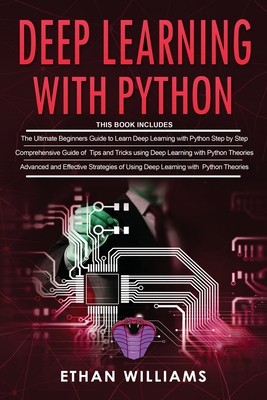| Deep Learning With Python: 3 Books in 1- The ultimate beginners step by step guide & Comprehensive Guide of Tips and Tricks & Advanced and Effect Contributor(s): Williams, Ethan (Author) |
|
 |
ISBN: ISBN-13: 9798649004763 Publisher: Independently Published OUR PRICE: $41.79 Product Type: Paperback - Other Formats Published: May 2020 |
| Additional Information |
| BISAC Categories: - Computers | Neural Networks - Computers | Programming Languages - Python - Computers | Programming - General |
| Physical Information: 1.16" H x 5.98" W x 9.02" (1.66 lbs) 572 pages |
| Descriptions, Reviews, Etc. |
| Publisher Description: Introduction 1Deep Learning with Python - The ultimate beginners guide to Learn Deep Learning with Python Step by StepYou have made a perfect choice to consider learning Python and most importantly to develop your skills in the programming world. A good choice comes with good tidings since you have you are looking at a highly comprehensive beginners' guidebook that will provide you with all the necessary steps and tips to get started. Deep Learning with Python - The ultimate beginners guide to Learn Deep Learning with Python Step by Step is packed with basic beginners' concepts, detailed examples and extra reminder exercises.Newbies are totally welcome to dive in You do not need any experience with programming whatsoever. Just have a notepad ready because taking short notes helps and get ready to play around with the samples and do a whole lot of coding The program was developed in December 1989 by Guido van Rossum. Guido's passion and hobby was to write and learn new codes that were available during his time. It is documented that he developed the python programming language while interacting and learning the ABC programming language.This is one of the best languages that you can choose to begin learning and at the end have a successful career in it. In summary, since the programming language was open-sourced, we expect a lot of advancements and developments on the language that will make it simpler and easier to use over the coming years.Introduction 2Deep Learning with Python - Comprehensive Guide of Tips and Tricks using Deep Learning with Python TheoriesThis book is designed to help you use Python for deep learning, including how to build and run deep learning models using Keras. This book also includes deep learning techniques, sample code, and technical content.The mathematical foundations of deep learning are subtle: but the average user doesn't need to fully understand the mathematical details to pick up the keyboard and start programming. Practically speaking, deep learning is not complicated, but the results are very objective. Teach you how to use deep learning: this is the purpose of this book.Introduction 3Deep Learning with Python - Advanced and Effective Strategies of Using Deep Learning with Python TheoriesThis book discusses the intricacies of the internal workings of a deep learning model. It addresses the techniques and methods that can not only boost the productivity of your machine learning architectural skills, but also introduces new concepts. Implemented correctly, these can set your deep learning model a league apart from all other models. This book not only focuses on theoretical and conceptual realms of such knowledge, but also gives equal importance to putting this information to the test. We do this by including some common practical examples and demonstrations that you would normally build deep learning for, hence giving you the best of both worlds. The main features of this book include: -Refreshing the fundamentals of a deep learning model and neural networks and connecting them with the advanced knowledge laid out in this book, reinforcing the reader's prior knowledge and transforming it into an expert-level understanding.-Emphasizing those tasks that are commonly demanded from deep learning models and breathing new life into them by introducing new techniques, methods, and elements that enable the model to drastically improve the performance of deep learning models on such tasks.-No usage of mathematical notations in the examples detailed in this book so that the concepts can be readily assimilated and mastered by programmers that do not have a mathematical background, hence prioritizing clarity of concepts.-Keeping this requirement in mind, the examples use Numpy code throughout as it best represents what the code actually means and its purpose.If you want to learn advanced strategies for Python this is the book for you. |